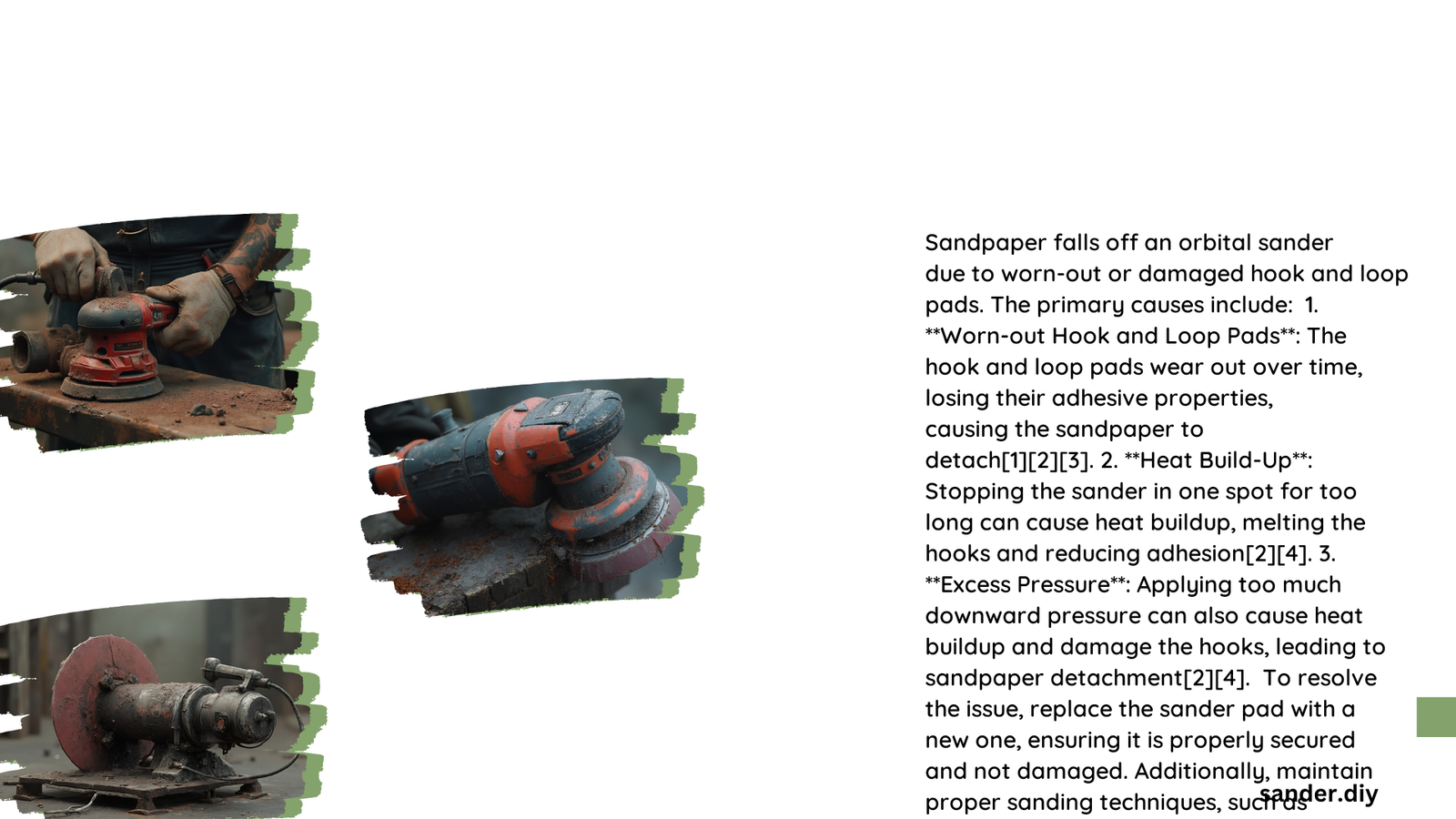Sandpaper falling off an orbital sander is a common issue that can significantly hinder your sanding projects. This problem often stems from improper pressure application, incompatible sandpaper types, or issues with the sander pad. Understanding the causes and implementing effective solutions can help ensure smooth, efficient sanding operations and prevent frustrating interruptions in your work.
Why Does Sandpaper Fall Off My Orbital Sander?
The primary reasons for sandpaper detachment from orbital sanders include:
- Excessive pressure application
- Incompatible sandpaper types
- Worn-out or damaged sander pads
- Poor alignment of sandpaper holes with sander pad holes
- Extreme temperature and humidity conditions
Let’s delve deeper into each of these factors and explore effective solutions.
What Causes Excessive Pressure on Orbital Sanders?

Applying too much pressure is a common mistake that can lead to sandpaper detachment. Here’s why:
- Overcompensation: Users often push harder when sanding isn’t progressing as quickly as desired.
- Misconception: Some believe that more pressure equals faster sanding, which is incorrect.
- Fatigue: As users tire, they may unconsciously apply more pressure.
Solution: Apply light, even pressure and let the sander do the work. The weight of the sander itself is often sufficient for effective sanding.
How Does Sandpaper Type Affect Adhesion?
Not all sandpaper is created equal, and using the wrong type can lead to adhesion issues:
| Sandpaper Type | Best Use | Adhesion Quality |
|---|---|---|
| Open-coat aluminum oxide | Woodworking | Good |
| Closed-coat aluminum oxide | Metal projects | Excellent |
| Silicon carbide | Glass, stone, metal | Variable |
Solution: Choose sandpaper specifically designed for your orbital sander model and the material you’re working on.
What Role Does the Sander Pad Play in Sandpaper Adhesion?
The condition and type of sander pad significantly impact sandpaper adhesion:
- Worn-out pads: Lose their ability to grip sandpaper effectively
- Damaged pads: May have uneven surfaces that prevent proper adhesion
- Incompatible pads: Some pads work better with certain sandpaper types
Solution: Regularly inspect your sander pad for wear and damage. Replace it if necessary, ensuring compatibility with your preferred sandpaper type.
How Important is Proper Hole Alignment?
Proper alignment of sandpaper holes with the sander pad holes is crucial for:
- Effective dust collection
- Preventing air pockets that can cause detachment
- Ensuring even pressure distribution
Solution: Take time to carefully align the holes when attaching sandpaper. Some sanders have guide marks to assist with this process.
Can Temperature and Humidity Affect Sandpaper Adhesion?
While specific data on temperature and humidity effects are limited, extreme conditions can impact adhesion:
- High temperatures: Can degrade adhesive properties
- High humidity: May introduce moisture, weakening the bond
Solution: Store your sander and sandpaper in a climate-controlled environment when possible. Allow materials to acclimate before use if moving between significantly different environments.
What Steps Can I Take to Prevent Sandpaper from Falling Off?
Follow these steps to minimize sandpaper detachment issues:
- Clean the sander pad thoroughly before attaching new sandpaper
- Use compressed air or a vacuum to remove dust and debris
- Inspect the pad for damage and replace if necessary
- Choose high-quality, compatible sandpaper
- Align holes carefully when attaching sandpaper
- Apply light, even pressure during sanding
- Consider using anti-clogging sandpaper or a lubricant to reduce friction
Are There Specific Tools or Materials That Can Help?
Yes, several tools and materials can improve sandpaper adhesion:
- Anti-clogging sandpaper: Reduces buildup that can cause detachment
- Sanding lubricants: Minimize friction and heat generation
- Pad saver discs: Protect the sander pad and improve adhesion
- Hole punch tools: Help create proper alignment for non-standard sandpaper
How Often Should I Replace My Sander Pad?
The frequency of pad replacement depends on usage, but general guidelines include:
- Light use: Every 6-12 months
- Moderate use: Every 3-6 months
- Heavy use: Monthly or as soon as signs of wear appear
Always inspect your pad before each use and replace it if you notice any damage or significant wear.
What Are the Cost Implications of Addressing This Issue?
Addressing sandpaper detachment issues can involve various costs:
- High-quality sandpaper: $5-$20 per pack
- Replacement sander pads: $10-$30
- Anti-clogging sandpaper or lubricants: $5-$15
- Pad saver discs: $10-$20
While these costs may seem significant, they’re often offset by improved efficiency and reduced material waste in the long run.
By understanding the causes of sandpaper detachment and implementing these solutions, you can significantly improve your orbital sander’s performance and reduce frustration during your projects. Remember, proper maintenance and technique are key to achieving smooth, professional results.
References:
1. [https://benchmarkabrasives.com/blogs/sanding/how-to-eliminate-swirl-marks-from-orbital-sanding]
2. [https://www.industrialsolution.ae/home-news-block-contents/six-orbital-sander-issues-and-how-to-fix-them]
3. [https://www.redlabelabrasives.com/blogs/news/common-orbital-sander-issues-solutions]
